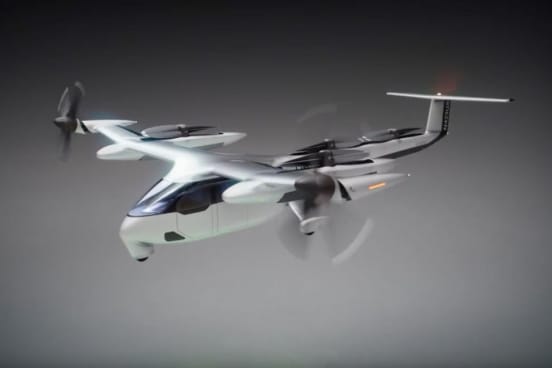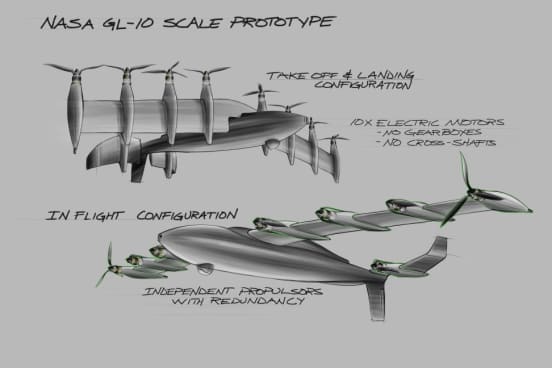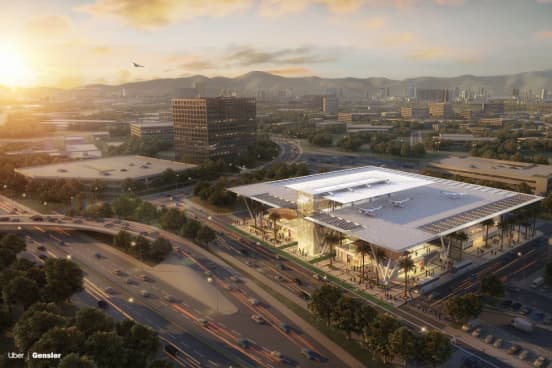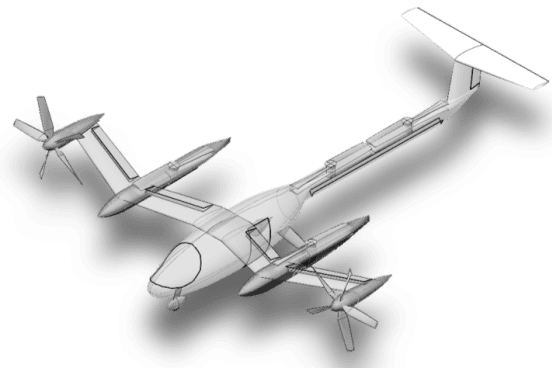Pivotal vehicle technology behind Uber Air
Distributed electric propulsion (DEP) is key to unlocking all-electric urban air mobility. DEP enables aircraft to have fault-tolerance in the vertical lift system, thereby increasing safety, reducing maintenance costs, and allowing operations that are up to one hundred times quieter than conventional helicopters. DEP together with current level of battery performance, lightweight composite materials and powerful automation, enables electric vertical takeoff and landing (eVTOL) aircraft which can efficiently operate in and around dense, urban cores.
Engineered safety
eVTOL aircraft will be certified by relevant civil aviation authorities. The DEP architecture facilitates redundancy at multiple levels (propellers, motors, electronics, batteries).
Quiet
Rotors with high solidity and low tip speed result in aircraft that have an acoustic signature that is nearly 20db, or about 100x, quieter than modern helicopters. Many eVTOL aircraft may fly in a wing borne configuration most of the time, resulting in virtually silent overflight.
Tailored Performance
From our deep understanding of mobility in urban areas, we know that Uber Air eVTOL aircraft will need to fly at a cruising speed of 150 mph or more with a typical cruise altitude of 1,000 to 2,000 feet above ground level. Combined with a range of up to 60 miles, these vehicles are designed to provide time savings to Uber riders on most of the trips they take each day.
Shared
Uber will leverage its rideshare technology to create pooled trips, when it is safe to do so, with up to 4 passengers, in addition to the pilot, in each Uber Air vehicle. This is key to establishing aerial mobility as a sustainable and affordable mode of transportation that will be accessible to a very large part of the community.
Green
Fully electric aircraft generate zero emissions while in flight. Coupled with a green electrical grid, they are part of the solution to address humanity’s climate change challenges. Ridesharing enables this new generation of aerial electric vehicles to not only be the fastest way to travel, but also to be a cost-effective form of zero-emission mobility.
VTOL aircraft
We believe that aerial ridesharing will enable rapid, reliable transportation through a network of electric vertical takeoff and landing (eVTOL) vehicles. Unlike helicopters, eVTOLs are all-electric. We’re developing vehicles with a focus on safety, minimizing noise, and energy efficiency.
Distributed electric propulsion
Since 2010, NASA and companies like Joby Aviation, Bell, and over 100 others have been working on a technological breakthrough in the aviation space. Distributed electric propulsion, DEP for short, is the first key to unlocking all-electric urban air mobility. DEP enables aircraft to be significantly safer through redundancy with multiple electric rotors.
Hub-to-hub mobility
eVTOLs don’t need to follow one-dimensional routes. Trains, buses, and cars move people from point A to point B along a limited number of ground-based routes, where a single interruption such as an accident or roadwork can cause a delay. eVTOLs, by contrast, can travel toward their destination independent of any specific path, complementing existing ground networks in cities.
Skyport infrastructure
Uber Elevate believes that developing a network of skyports to support an urban eVTOL network would be more cost- and space-efficient than infrastructure-heavy and capital-intensive approaches such as roads, rails, bridges, and tunnels. Our designs make use of repurposed decks of parking garages and existing helipads that will create the basis of an extensive, distributed network of skyports in the future.
Data-powered networks
Uber's database provides dynamic insights about traffic and mobility patterns in cities where we operate. By using this data, we can carefully model demand and work with cities, existing mobility and transit operators, and real estate developers to make informed decisions about where skyports should be placed in cities. The data will also help us better understand the demand for this new type of transportation.
eVTOL common reference models
Led by Mark Moore, the NASA engineer who pioneered distributed electric propulsion (DEP), Uber’s Vehicle Engineering team has developed eVTOL common reference models (eCRMs) based on Elevate vehicle requirements. The eCRMs facilitate collaboration with our design and manufacturing partners and have been designed with a focus on technological capabilities and city and safety regulations. Requirements include 150 mph cruise speed, 60-mile sizing range, a 3-hour sprint of 25-mile trips, and capacity for one pilot and 4 riders.
User-focused design
In a strong commitment to the future, Safran Cabin's design and innovation studio has collaborated with Uber to develop a purpose-built cabin for aerial ridesharing.







